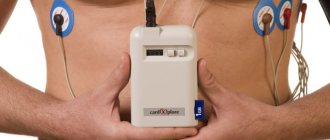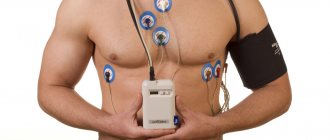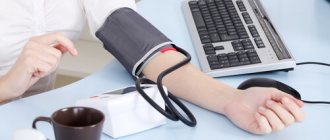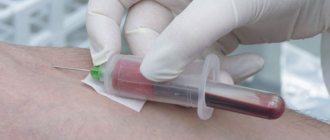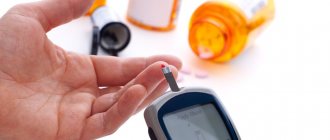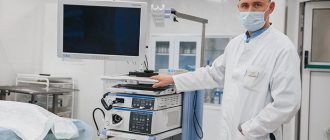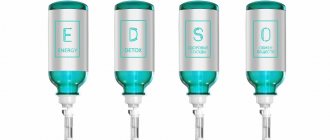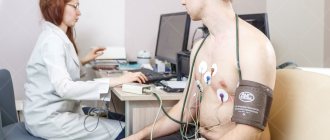Reminder for the patient when wearing Holter ECG 08/18/2019 21:21
Tips for the patient when wearing a Holter ECG (daily examination of ECG and blood pressure)
It is prohibited: to open the cover of the device and change the batteries.
If you have a regular recorder and regular ECG electrodes, then you should avoid an aquatic environment: wash, go to the sauna, swim in the pool, sweat a lot... But you can wipe yourself with a damp towel, trying not to touch the cable and electrodes! During monitoring, you should not wear synthetic or woolen underwear (cotton only). While you sleep, you can place the monitor next to you (or under your pillow).
Allowed: Be sure to follow the doctor’s orders while wearing a 24-hour Holter ECG and blood pressure, no matter how absurd they may seem to you. Lead a normal life!
Required: Keep a diary with notes about your actions in everyday life!
For example, marking the time you take medications. There is no need to celebrate going to the toilet if you don’t feel anything special about your health. I recommend checking the box “emotional physical stress” (sex) to identify the dangers of such stress! And be sure to follow all the doctor’s recommendations, indicating the time of their implementation. For example: stress stair test with a number of steps, walking, running, lifting weights, etc. Everything you usually do in your life. The more honest you are in your diary, the more accurate your doctor's diagnosis of your heart condition will be.
For example, to detect atrial fibrillation, it is sometimes necessary to wear a Holter ECG for several days. Agree, it will not be possible to limit ordinary life in this case.
SO: let's list in more detail everything that is possible and what is not recommended to do while wearing a 24-hour ECG and BP recorder (Holter recording).
If you have sensitive skin, it is better to tell your doctor about this before the examination.
1. When using the device, it is better to have a doctor’s certificate about the installation of the device in order to avoid questions from police officers who may inadvertently mistake you for a terrorist.
2.What should I do if the ECG electrode comes off while changing clothes or while sleeping?
Ideally, you need to have 1-2 spare electrodes during the examination in order to re-glue them. But doctors don’t give spare electrodes with them! Mostly because you won’t be able to glue it correctly on your own. Moreover, re-gluing the electrode to the same place does not lead to long-term results - the electrode is disposable. So what to do in this case? Nothing! Of course, the recording will not be complete, but the program will be able to decipher the ECG. How? The doctor himself already knows this.
If all the electrodes and the cable along with them are “torn off,” then there is no choice. You need to go to the clinic for re-equipment. This often happens in the second part of the day or at night, and recording more than 12 hours may be enough for a doctor to diagnose your condition.
3. You noticed that the “Holter” stopped showing signs of life or beeped strangely…. A squeak or shutdown is due to premature discharge of the batteries. If you can find exactly the same ones, a replacement will save the day. Modern Holters have special batteries that cannot be replaced or recharged at home!
Advice: do nothing and continue wearing it, even if you are sure that it has turned off.
4. In addition to recording an ECG, some devices measure blood pressure at a specified time interval. This is uncomfortable, but necessary, be patient! When measuring blood pressure while moving, it is recommended to stop while the measurement is taking place. It is not necessary to sit down, just stand quietly.
5. Do not expose the device to shock, vibration, high or low
temperatures Do not use near aggressive agents (acids).
And most importantly, eliminate forced radio emissions from your life: EHF procedures and others. Minimize the amount of time you spend using your cell phone; at a minimum, turn off cellular and data communications or place it on a nearby table! Talk on your cell phone as little and as briefly as possible. This will eliminate false positives of the program when processing your record and FALSE DIAGNOSIS of a disease that you have never had! It will also eliminate noise from that section of the ECG recording where the doctor will diagnose your disease on the daily ECG recording. Take care of yourself!
Contraindications and side effects:
Holter monitoring is an absolutely painless procedure.
It has no contraindications. Can be used during pregnancy and breastfeeding, as well as in the elderly and children.
Does not cause side effects.
Holter ECG, or daily heart monitoring: the essence of the examination
To obtain the above data, an electrocardiogram (ECG) is needed over a long period of time. To do this, electrodes similar to a conventional examination are attached to the patient’s body and connected to a wearable cardiac recorder. The information is read by the device and recorded on a memory card, and then transferred to the functional diagnostics doctor for interpretation and conclusion. Such an examination can last up to seven days.
24-hour ECG monitoring was first used by American biophysicist Norman Holter in 1952, which is why the method is often called the “Holter ECG.” With the advent of this technology, it has become much easier to identify disturbances in heart rhythm and conduction, clarify the cause of sudden fainting, evaluate the performance of the pacemaker, and identify ischemic changes in the patient.
A heart monitoring device (monitor) looks like a small box with a memory card inside. Wires are connected to it, leading to several disposable electrodes on the patient's body. The recorder itself is in a case on the belt to make it convenient to carry. After the end of the daily ECG, the electrodes are removed, and the device is connected to a computer, where the data becomes available to the doctor. The main condition for wearing the device is physical activity, unless there are contraindications.
In some cases, the patient is also prescribed a daily blood pressure measurement. Then a tonometer cuff is added to the equipment described above, which records blood pressure and also transmits information to the monitor.
The recorder records the heart rhythm during the day, and the patient at this time keeps a diary in which he records the time of sleep, work, eating, walking up the stairs, etc. The doctor may also ask the patient to perform tasks while wearing the monitor: for example, spend 5 minutes lying in a certain position (on the back, side, stomach) and indicate the time in the diary. So daily ECG monitoring will be as informative as possible.
Indications and contraindications for 24-hour cardiac monitoring
Daily monitoring of heart function is prescribed in the following cases:
- to identify arrhythmia, if there are complaints of interruptions or pauses in the heart rhythm, too fast or very slow heartbeat, dizziness or fainting;
- to identify ischemic conditions (oxygen starvation) of the myocardium: the patient may complain of pressing pain in the chest, elbows and lower jaw;
- to monitor certain parameters of the pacemaker;
- to assess the effectiveness of the prescribed treatment.
Some heart rate monitoring devices allow for initial diagnosis automatically. But you should not completely rely on this data; the final conclusion can only be given by the doctor after analyzing the decoding of the data.
Other indications for cardiac monitoring are:
- strong heartbeat;
- angina pectoris;
- myocardial infarction;
- cardiomyopathy.
Only acute inflammatory heart diseases are considered a contraindication to daily ECG measurements. In all other cases, the examination does not cause harm (and is absolutely painless), including during pregnancy, childhood and old age.
Heart monitoring procedure: procedure
Many patients are interested in how 24-hour heart monitoring is carried out, how the device will be installed, and whether it is necessary to consult a doctor.
- First you need to get a doctor's prescription. There should be a clear direction for the purpose of the study, as well as recommendations: for example, whether any medications taken should be stopped while monitoring is carried out.
- Before the examination, you are advised to get enough sleep and start the day as usual. It is advisable to take a shower without lubricating your skin with anything after it. If there is hair on the chest, it should be shaved for better contact of the electrodes with the skin and subsequent painless removal. It is advisable to wear loose clothing to hide the device and electrodes and to walk comfortably with them. Women should not wear a bra with underwire.
- In the treatment room, a nurse places adhesive, disposable electrodes on the front of the patient's chest. Usually there are five to seven of them, but the number can reach up to 12. Sometimes one electrode is attached closer to the groin. The device itself is in a special bag; it can be hung around your neck, over your shoulder or on your belt.
- The recorder is also turned on by the nurse, and after that the device no longer needs to be touched until the end of the examination. Sometimes the patient is instructed to press a button at a certain moment, but this does not happen every time.
- Daily heart monitoring is not necessarily carried out throughout the day. The duration of the study is determined by the doctor. After the appointed time has expired, the patient returns to the treatment room, where the device and electrodes are removed from him, the quality of the data recording is checked, and they are sent for decoding.
- During the examination, the cell phone should not be in your pocket, and it is also prohibited to approach electrical devices with radiation.
Comments
No comments yet
Please log in to post a comment.
Thanks to modern technologies, a medical examination of a person allows us to identify and establish the most accurate changes occurring in the body.
The method of functional research includes Holter monitoring, which helps to monitor the electrocardiogram per day. ECG recordings are carried out continuously for two to three days, and they are then deciphered by a cardiologist.
The name of the Holter monitoring procedure comes from the name of the researcher who was the very first to use this device in practice (1961). An ECG holter is a portable recorder that is small in size; it records the functioning of the heart, recording information about its work throughout the day.
During this time, the device records the emerging features of the heart rhythm. The doctor may prescribe a diagnosis using a Holter monitor if a regular cardiogram provides insufficient information about the condition of the patient’s heart.
Existing indications for Holter monitoring
A Holter ECG performed by a doctor can be mainly prescribed to identify any heart rhythm disturbances that are quite difficult to detect during a regular electrocardiogram, that is, a short-term diagnosis.
Sometimes it happens that low-characteristic contractions specific to healthy heart muscles tend to manifest themselves only during times of strong emotional disturbances, possibly strong physical exertion.
In such cases, it is impossible to reflect such changes using a conventional electrocardiogram, and when performing Holter monitoring, the patient is able to lead the lifestyle to which he is accustomed, for example, perform various types of work, perform physical activity, and assume different body positions.
Holter diagnostics also allows you to identify any disturbances in the process of supplying the heart muscle with blood, especially the rise or fall of the ST segment during exercise.
The results of this diagnostic method
The nurse or cardiologist removes the Holter monitor from the patient, and the patient, in turn, provides completed records of physical activity; the symptoms shown require further interpretation.
The doctor, taking into account the results obtained, the doctor can make a diagnosis, if necessary, prescribe appropriate treatment, or when the origin of the detected disorders is not clear, the specialist will prescribe further examination to the patient.
For example, a patient will need to wear a device that records their heart rate for a short period of time. The patient can independently activate it; to do this, they only need to press a button during the period when cardiac symptoms of a serious nature appear.
Also, while determining changes in the process of blood supply to the heart muscle, the patient may be prescribed to do a stress electrocardiogram, and in some cases even perform angiography.
Installation method for such a device
Before fixing the device on the patient’s body, the doctor will recommend taking a shower. This is explained by the fact that water should not get on the patient’s body for at least 24 hours, since the monitor cannot be removed.
The doctor attaches the electrodes to the patient’s chest, determines, and, if necessary, adjusts their correct position. Then the electrodes are connected to the wiring of the device that conducts the fixation. The device is attached to the patient’s body using appropriate straps.
The doctor instructs the patient and talks about the correctness of keeping a diary, which will subsequently allow him to correctly interpret the information that will be received from the device.
The patient will need to record periods of physical activity, sleep, rest and wakefulness, including the appearance of all symptoms: the occurrence of pain in the chest, the appearance of arrhythmia, tachycardia, etc., and the exact time should be indicated. Once the device is installed, the patient can begin to carry out their daily activities and lifestyle.
Holter monitoring does not cause any pain; the patient may feel some discomfort only while wearing the device. The patient is recommended to lie only on his back during sleep, as this will help to avoid displacement of the electrodes, which may interfere with the recording of indicators.
Archiving and submission of research.
1. In the patient log window, you must select the study that you will archive.
2. Click the right mouse button and in the menu that appears, select the line “export research to file”
3. To save the archive to a folder on your desktop, click the open folder icon.
4. In the address bar, select the path to save; the default folder is on the desktop. At the bottom, enter the file name with the patient's last name and click save.
5. Next, click the “start data export” button
6. After a message appears indicating that the export is complete, the program can be closed, and the saved archive must be uploaded to your personal account on our remote decryption service website.
What is the essence of the technique?
The technique is based on ECG (electrocardiography), which is carried out over a long period of time - from one day to seven. A special device - a recorder (or registrar) - records ECG readings for the entire period of wearing. Recording is most often carried out through 2-3 (up to 12) channels, that is, electrodes. The recording is stored in different ways - either on magnetic tape or in the electronic memory of the device.
In addition, recording can be carried out throughout the allotted time without interruption, or only excerpts (events) are noted. The device itself is attached using a belt on the belt.
In most cases, multichannel data obtained by Holter do not coincide with the results of a surface ECG, so both of these studies are performed.
Cardiologists at our clinic use this type of diagnostics of heart problems along with ECG. Before conducting a Holter examination, our doctor will tell you in detail how to use the device correctly and explain all the nuances of Holter monitoring that you need to know.
How to wear a halter correctly
During the diagnostic period, it is necessary to ensure that the device is not overcooled and does not come under the influence of a magnetic field. You need to follow your doctor's recommendations and ensure that the electrode is firmly attached to the body. In rare cases, the cardiologist decides to use a portable recorder for diagnosis, recording data “on demand”.
It is very important to understand how to remove a halter correctly. You need to check with your doctor in advance about the order in which you should proceed. In most cases, it is enough to simply peel off the sensors and remove the device. Even when the battery is disconnected, the received data remains in memory.
How is data obtained during Holter monitoring analyzed?
The data collected by the device is processed using special computer programs, but there are no uniform standards for data analysis yet, so all indicators must be reviewed by a doctor. When deciphering Holter indicators, the following parameters must be indicated:
- heart rhythm and its disorders;
- pauses in rhythms;
- interval changes;
- correlation between Holter indicators and the patient's diary.
Each change in heart rate should be illustrated by the corresponding moment on the cardiogram tape.
Decrypted data
On the results sheet you will see the following indicators.
| Index | Norm |
| Average heart rate during the day | 60–100 beats per minute |
| Average heart rate at night and during daytime sleep | 41–81 beats/min |
| Daily graph of heart rate changes | Changes when changing activities |
| Number of supraventricular extrasystoles | Up to 960 supraventricular extrasystoles per day (up to 40 pcs. per hour) A slight excess of the norm (up to 1200 pcs. per day) does not pose a threat to life and health |
| Number of ventricular extrasystoles | The absolute norm is 0. The permissible quantity that does not threaten life and health is 200 pcs. per day |
| The duration of the QT and PQ intervals and the schedule of their changes. | Normal QT interval: 340–450 ms (0.34–0.45 s) for women and 340–430 ms for men PQ – 120–200 ms |
Note! The norms indicated in the table are averaged and do not take into account age and individual characteristics of the body. Ask your doctor about the norm for you personally.
Who is Holter monitoring indicated for?
According to the observations of our doctors, wearing a Holter monitor is the most effective way to diagnose heart rhythm disorders.
Your doctor will prescribe you to wear a halter in the following cases:
- loud heartbeat;
- interruptions in heart rhythm;
- fainting of unknown etiology;
- upcoming heart surgery;
- congenital heart defects, diabetes mellitus, apnea;
- so-called “silent” myocardial ischemia (no pain)
- interruptions in the operation of the pacemaker, etc.
Unfortunately, if you suffer from coronary heart disease (CHD), the results of Holter monitoring cannot provide an objective picture. You should also know that if no pathology was identified during the study, this is not a 100% guarantee of its absence.
Popular questions about Holter often asked by our patients
Is it possible to use a mobile phone while wearing a halter?
Answer: Yes, you can. The electrocardiography signal travels through the electrodes, and radio interference does not have a significant effect on it.
Can I wear a monitor to work or do I need to take time off?
Answer: The main purpose of Holter monitoring is to study the work of the heart during the patient’s normal life. During the procedure, it is not recommended to change the usual daily routine: the patient goes to work, does housework, communicates with friends, etc.
However, a person with a halter may cause some suspicion when undergoing a personal search, for example, when entering a train station or airport. To avoid an unpleasant situation, your attending physician will issue you a certificate confirming the need to wear the equipment with a photograph of the device and the clinic’s seal.
Can some electrical devices affect the performance of the sensors?
Answer: There is no official data on this issue. However, some electrophysicists argue that if Holter monitoring is based on the ECG principle, then electromagnetic radiation from household appliances, such as microwave ovens, can affect the results. In addition, for the purity of the study, you should not go through magnetic frames and metal detectors. Our experts recommend avoiding contact with electromagnetic equipment to avoid damage to the holter and obtaining inaccurate results.
Can children wear a halter?
Answer: Yes, you can. Most often, children are assigned to all 12 channels of the device. Holter monitoring will require close attention from parents. Children, unlike adults, are very active and make a lot of sudden movements. This can lead to unclear results and sometimes even damage to the instrument. Very young children may tear the electrodes off their body, making the test impossible. Therefore, if your child is prescribed by a doctor to wear a halter device, be very careful. Try to explain to your child that this study is very important and the holter must be handled very carefully.
Does the device interfere with normal sleep?
Answer: Naturally, like any foreign object attached to the body, a Holter monitor can cause some discomfort during sleep, so you should be careful and sleep on your back or side.
Is it possible to wash while wearing a Holter monitor?
Answer: The Holter monitor, like any electrical device, cannot be wetted with water, as it can be damaged by moisture that gets into it. Swimming, bathing, visiting the bathhouse and sauna while wearing a halter is prohibited. Washing your face, washing your hands and feet is not prohibited.
How is the examination carried out?
There is no need to take special measures before Holter monitoring, but it is still worth notifying your doctor first about what medications you are taking so that he can take this into account when analyzing the data obtained (some groups of drugs affect heart rate and other indicators). It is also better to take a shower in the morning, because... contact with water will be prohibited for 24 hours (or more). All metal products must be removed from the body, after which the following occurs:
- The patient assumes a horizontal position.
- The doctor, having processed the electrodes, fixes them on the chest, and also issues a halter, which must be carried with you at all times.
Benefits of Holter monitoring at home
- High information content of the study. ECG registration is carried out during the patient’s normal activity, for 24-72 hours, which increases the accuracy of the results. Allows you to comprehensively assess blood pressure levels throughout the day.
- Comfort. To carry out diagnostics, compact portable equipment is fixed on the belt. The device does not cause discomfort to the patient. It is important that you do not need to change your lifestyle and operating conditions in order to undergo diagnostics.
- Qualified specialists. The results are interpreted by experienced functional diagnostic doctors who specialize in diagnosing cardiac diseases.
What is the essence of the procedure and who needs it?
First you need to understand what it is – Holter ECG monitoring. The decoding of the last word is known to everyone - “echocardiogram”, as for Holter, it is a small portable device that collects and records blood pressure data, as well as the received cardiogram information. Accordingly, the procedure involves monitoring and recording the work of the heart and the state of blood circulation, which can be carried out within 12 hours, a day or even a week - the period depends on the reasons why the doctor ordered this examination.
Indications for this type of check are any patient complaints about regular heart rhythm disturbances, especially accompanied by dizziness and/or loss of consciousness. Referrals for this procedure are mainly issued for:
- assessment of blood supply to the heart muscle;
- monitoring of persons with suspected ischemia;
- checking the effectiveness of prescribed treatment;
- monitoring of persons with heart defects.
Also, Holter blood pressure monitoring makes sense in cases of hypertension (as a primary diagnosis and as a susceptible severe degree), the presence of a pacemaker, a previous heart attack, exacerbation of heart failure and other cardiac problems. In some cases, even people with thyroid diseases are examined, and at the same time undergo hormone tests.
